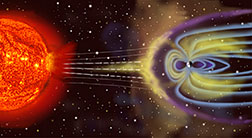- Number 404 |
- January 6, 2014
PPPL joins forces with Princeton in a new center to study volatile space weather and violent solar storms

Computer simulation of the solar wind in
contact with the Earth’s magnetosphere.
The streaming wind compresses the
magnetosphere on the side of the Earth
that is nearest the sun, and stretches the
magnetosphere into a long “tail” as the
wind blows past the Earth and farther
away from the sun.
Researchers at Princeton University and DOE's Princeton Plasma Physics Laboratory (PPPL) have launched a new center to study the volatile heliosphere — a complex and frequently violent region of space that encompasses the solar system. This region is carved out by the solar wind — charged plasma particles that constantly stream from the sun — and gives rise to space weather that can disrupt cell phone service, damage satellites and knock out power grids.
Such stormy weather results from solar flares and coronal mass ejections — huge solar eruptions that periodically hurl millions of tons of electrically charged plasma particles into the heliosphere. Eruptions that slam into the magnetosphere — the magnetic field that surrounds the earth and extends some 75 million miles into space — can trigger disturbances called geomagnetic storms. One notable outburst blacked out the Canadian city of Montreal and most of the province of Quebec for 12 hours in 1989.
The newly formed Princeton Center for Heliospheric Physics aims to sharpen the capacity to predict solar eruptions and to deepen understanding of the plasma flows and magnetic forces that emanate from the sun. “All this is the domain of heliospheric physics,” said Amitava Bhattacharjee, head of the Theory Department at PPPL and co-director of the new center with PPPL physicist Jay Johnson.
The center combines the resources of Princeton’s Department of Astrophysical Sciences and PPPL and facilitates collaboration between them. For example, the joint enterprise will bring together Princeton work on an explosive phenomenon called magnetic reconnection with PPPL research on the subsequent acceleration of plasma particles caused by waves in the plasma, which takes place in the inner magnetosphere — the section closest to Earth. Such processes underlie geomagnetic storms and related phenomena known as substorms. “Having these complementary efforts within the center provides us with the essential tools for better understanding of space weather,” Johnson said.
Contributors to the center include Princeton astrophysicists James Stone and Anatoly Spitkovsky, whose focus on plasma dynamics beyond the solar system is closely related to issues that heliospheric scientists face. “We plan to share knowledge, computational tools and results in a way that will benefit all parties,” said Stone. “We are lucky to have this new center right next door at PPPL.” Further tying together such efforts is the website helio.pppl.gov that PPPL physicist Eun-Hwa Kim designed and manages.
Key center projects include:
- Development of a computer code to model as precisely as possible the physics behind the role of magnetic reconnection in geomagnetic storms. Current codes can’t provide detailed descriptions of the movement of charged particles during reconnection events, in which the magnetic fields in plasma break apart and reconnect with the force of millions of tons of TNT. “It has become clear that while these models are powerful, important effects are missing,” Bhattacharjee said.
-
Funds for this project come from a five year, $3.5 million grant from the National Science Foundation (NSF) and the National Aeronautics and Space Administration (NASA) to five institutions, with the new center receiving $1.25 million, the largest single slice. Each institution is to model a different aspect of space weather in what NSF termed “a theoretical and computational grand challenge.” Participants in addition to Princeton include the University of New Hampshire, the University of California-San Diego, Los Alamos National Laboratory and NASA’s Godard Space Flight Center.
- Studies of the interaction between the solar wind and the magnetosphere that affect the Earth. This interaction redistributes mass and energy throughout the magnetosphere and can whip up disturbances that pose danger to spacecraft and to the human exploration of space. The dynamics of these processes in the inner magnetosphere — the near-Earth portion of the field — is a key focus of researchers in the PPPL theory group who are members of the center.
- Research on heliospheric topics ranging from solar radio bursts that can disrupt cell phone service to the turbulent transport of plasma particles in the magnetosphere to the behavior of plasma waves in the magnetic field that surrounds the planet Mercury. Broad funding for the center’s work on such topics comes from NSF and NASA.
[John Greenwald, 609.243.2672,
jgreenwa@pppl.gov]
